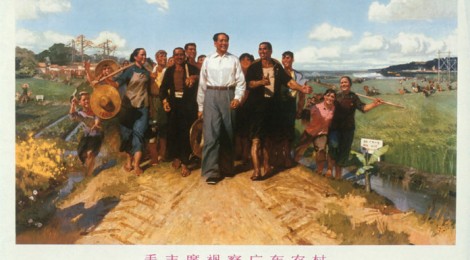
Mao decides to ‘Make China Great Again.”
With Trumps policies soon to be implemented, who can forget a very similar time and place. Mao Zedong’s ‘Great Leap forward’ in 1958. Maybe the worst leadership decision, in terms of millions of lives ruined, that sets the bar for the Trump era.
 The Great Leap Forward was a disastrous attempt in 1958 by Mao Zedong to rapidly industrialize China. He would turn China’s economy from agriculture to Steel production, just like America and to do this he had to produce a lot of steel; a science in which he had no familiarity. He banned all private holdings and created communes where peasants who no longer owned their own land would live together be forced to work steel instead of farming.
The Great Leap Forward was a disastrous attempt in 1958 by Mao Zedong to rapidly industrialize China. He would turn China’s economy from agriculture to Steel production, just like America and to do this he had to produce a lot of steel; a science in which he had no familiarity. He banned all private holdings and created communes where peasants who no longer owned their own land would live together be forced to work steel instead of farming.
Each farm would be given a steel furnace and often every peasant in the commune was forced to work long hours. Mao also tried to improve farming through a number of misguided techniques set forth by Trofim Lysenko. The techniques decreased grain production but local leaders were under so much pressure that they falsely reported large increases in grain production in order to please their superiors.
Unfortunately, these numbers were used to determine how much grain was sent to the capital to be used for export, the false numbers meant little if any grain was left to feed the peasants.
All steel products – like farming equipment – had to be handed over to the government for steel production. But Mao knew very little about the process of making quality steel. The Steel manufacture turned out to be faulty. Without the tools to continue farming, the great leap forward became the great starvation for the disempowered farmers. And many millions died.
Counting the consequences is not precise but safely, somewhere between 30 and 50 million people died.
( Banister’s estimate of 30 million excess deaths to be “the most reliable estimate we have” Rummel initially took Coale’s 27 million as a “most likely figure”, then accepted the later estimate of 38 million by Chang and Halliday after it was published. Dikötter judged Chen’s estimate of 43 to 46 million to be “in all likelihood a reliable estimate.” Yang takes Cao’s, Wang Weizhi’s, and Jin Hui’s estimates ranging from 32.5 to 35 million excess deaths for the period 1959–1961, adds his own estimates for 1958 (0.42 million) and 1962 (2.23 million) “based on official figures reported by the provinces” to get 35 to 37 million, and chooses 36 million as a number that “approaches the reality but is still too low.” )
Casualties have indeed appeared among workers, but it is not enough to stop us in our tracks. This is the price we have to pay, it’s nothing to be afraid of. Who knows how many people have been sacrificed on the battlefields and in the prisons [for the revolutionary cause]? Now we have a few cases of illness and death: it’s nothing!
During a secret meeting in Shanghai in 1959, Mao demanded the state procurement of one-third of all grain to feed the cities and satisfy foreign clients, and noted that “If you don’t go above a third, people won’t rebel.” He also stated at the same meeting:
When there is not enough to eat people starve to death. It is better to let half of the people die so that the other half can eat their fill.
Peasants were confined to their starving villages by a system of household registration and the worst effects of the famine were directed against enemies of the regime. Those labeled as “black elements” (religious leaders, rightists, rich peasants, etc.) in any previous campaign were given the lowest priority in the allocation of food, and therefore died in the greatest numbers. No group suffered more than the Tibetans with perhaps one in five dying from 1959 to 1962
30 to 40% of all houses were also destroyed as part of the Great Leap Forward as the materials were needed for their efforts to industrialize.
The four pests campaign accompanied the Great Leap Forward, where all sparrows were killed as pests, affecting the food chain leading to proliferation of bugs that were formerly eaten by sparrows, killing crops.
Even as Mao knew his people were starving, and the Steel production was a disastrous failure, he continued to export grain in order to save face knowing millions would die through his ego driven program. The Great Leap (1958 – 1961) was the only time between 1953 and 1973 that the economy regressed. Officials who had disappointed Mao with harvest reports were publicly executed and Mao took a backseat to government affairs for several years, while still enjoying a lifestyle of indulgence and excess.

Comments are closed, but trackbacks and pingbacks are open.